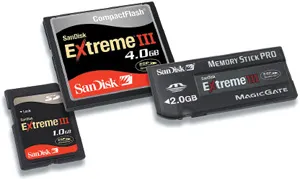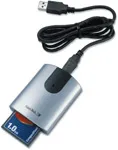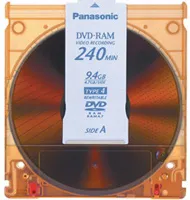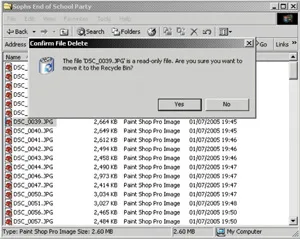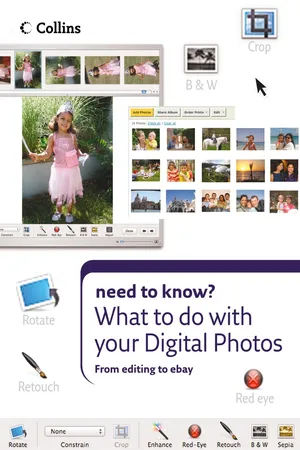![]()
1
Organizing your photos
If you have owned a digital camera for some time, you have probably taken lots of photos with it. If all has gone well, you will doubtless have been impressed with the results. of your artistic efforts, but you may still feel, somehow, that something is lacking. Perhaps, having gone to the effort of getting the camera and then learning how to use it, just having several memory cards’ worth of digital image files seems a bit of an anticlimax. You need to liberate your images and get more out of them. To begin this process, you must get your images properly organized.
![]()
Transferring your images
The first thing to do in terms of organizing your photographs properly is to get them off your digital camera and safely stored elsewhere. In order to do this you will need memory cards or a portable storage unit as an interim back-up measure prior to downloading your images onto your computer.
must know
There is much more to a memory card than just its storage capacity – the speed at which it can store your image or transfer it can be very important, as well. This is especially true if you shoot a lot of photos in quick succession, or use your camera’s video facility often.
Cards and portable storage units
When you take a digital photograph, the image is stored as a series of data bits on the memory card. The memory card is just like a computer hard drive, in that it needs to be formatted before you can use it. The process of formatting sets up a digital storage structure that is recognized by the camera. In doing so, it blanks out any information that was already on the card, and bypasses any damaged memory sectors. Consequently, it is good practice to re-format a card rather than simply deleting any images that are already stored on it. To re-format your memory card, you simply go to the main menu on your camera, select ‘Format’, and select ‘OK’. The camera will then display a message or symbol that indicates that it is in the process of formatting. It usually takes a few seconds to complete.
Most memory cards will do the job they were designed for very well. However, if you need extra fast image storage, then you will need professional quality items, such as these Extreme III cards.
No matter what kind of digital camera you have, it is a very good idea to obtain several memory cards – the bigger their capacities, the better. After all, if you have plenty of card space, you will be able to try taking lots of experimental shots without having to worry about running out of storage room. When digital cameras first came out, memory cards were very expensive. These days, however, they are much more affordable. An alternative is to buy some form of portable storage device such as a battery-powered CD writer or a dedicated photo archive unit like the Nikon Coolwalker. The latter offers 30GB of storage, which means it can store as many as 10,000 2MB photos.
Card readers and memory sticks
While it is possible to download images directly from your camera’s memory card to a computer (while it is still in the camera), it is something that should only be done if there is no other option available to you. This is because the process is very slow, and if the card is full, it could take hours to complete. Instead, you will find that a good card reader – a device that plugs into your computer and that you insert your card into – will save a lot of time and effort.
One handy solution to the problem of how to transfer large numbers of image files in a quick and easy manner is the memory stick. This useful device is also known as the data pen – because it stores data and is designed to be carried in the pocket. However, use a memory stick as a temporary storage device only; think of it as a convenient way in which to transfer images rather than to store them.
A card reader is a device that is used to transfer digital images quickly and easily from a memory card to some other piece of equipment, such as a computer.
USB memory sticks – or data storage pens – plug neatly into the keyboard of some computers for maximum ease of use. Alternatively, they will plug into any USB port on a standard CPU.
![]()
Rescuing lost photos
One of the most frustrating things you can experience in digital photography is accidentally deleting images. Fortunately, there are several ways to rescue lost images, but the best method is to make sure that you only delete images which have already been downloaded onto a computer hard drive or a CD.
Back-up CDs for insurance
One way to avoid disasters is to make sure that you always carry several freshly formatted memory cards (see ); that way, if one of them fails, you will always have another to hand which will enable you to replace the images you lost on the first card. You should also never leave the house without making sure that any existing card content has been safely stored elsewhere. However, before doing any card re-formatting – which necessarily involves deleting old images – it is always worth double-checking that the back-up storage method you have chosen is working efficiently. If you have burnt your images onto a CD, for instance, make sure that you can view them properly. Occasionally discs do not ‘burn’ correctly (see) and images may not have recorded. Imagine your frustration if you were to re-format a card believing all your images to be safely backed-up when in fact your storage disc had completely failed?
must know
If you decide to invest in a high capacity memory card you will obviously be able to fit a larger number of images on it. A failure, however, would result in you losing many more of your treasured images. If you are photographing something important such as a wedding, it is therefore worth spreading your shots over several cards by regularly changing them around.
The best way to avoid losing your images is to keep emergency back-ups on disc.
You will find it easier to avoid deleting the wrong files by mistake if you take the time to label them properly. Here it is impossible to tell from the filename which image is about to be deleted.
Do you have enough power?
Another issue to look out for is the battery level on your camera. In the case of some cheaper cameras that have a fixed memory (that is, no removable card), if the battery goes flat during a download, it can result in a loss of images. It is also worth making sure that you do not turn off the power on your camera until it has finished processing the last image, or else you will lose it forever.
Disgo make a variety of portable data storage devices. If you buy one of these and back-up images as soon as they are taken, you will avoid the pain of loss due to failing camera batteries or similar.
Usually, there is an indicator light somewhere on the camera body which shows what is going on. This is generally only a problem with larger file formats, such as ‘RAW’ files, which can take half a minute or more to process in extreme cases. Probably the most common way in which photos are lost, however, is during the editing process; this will be covered in detail later in the book, but it is worth saying twice – before you edit a photo, make a back-up copy of it, and NEVER edit the original.
Recovery strategies
If you find that you have accidentally deleted some images while they are still in the camera, then stop and think before you do anything else. This may have occurred as the result of a simple deletion, or through an accidental card re-format. Either way, do not take any more photos as they will almost certainly over-write the deleted ones (if this happens, your images will be gone forever). Ask yourself how important those photos were. Can you do without them? If so, consider yourself lucky, and try not to do it agai...

